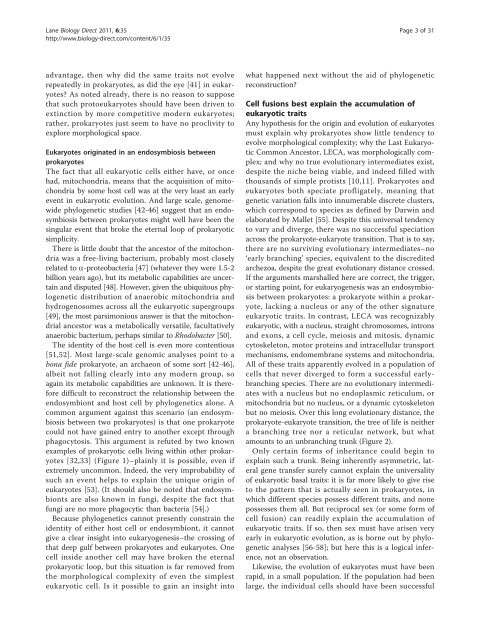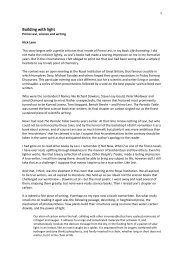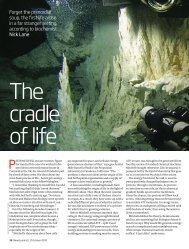Energetics and genetics across the prokaryote ... - Biology Direct
Energetics and genetics across the prokaryote ... - Biology Direct
Energetics and genetics across the prokaryote ... - Biology Direct
You also want an ePaper? Increase the reach of your titles
YUMPU automatically turns print PDFs into web optimized ePapers that Google loves.
Lane <strong>Biology</strong> <strong>Direct</strong> 2011, 6:35http://www.biology-direct.com/content/6/1/35Page 3 of 31advantage, <strong>the</strong>n why did <strong>the</strong> same traits not evolverepeatedly in <strong>prokaryote</strong>s, as did <strong>the</strong> eye [41] in eukaryotes?As noted already, <strong>the</strong>re is no reason to supposethat such protoeukaryotes should have been driven toextinction by more competitive modern eukaryotes;ra<strong>the</strong>r, <strong>prokaryote</strong>s just seem to have no proclivity toexplore morphological space.Eukaryotes originated in an endosymbiosis between<strong>prokaryote</strong>sThe fact that all eukaryotic cells ei<strong>the</strong>r have, or oncehad, mitochondria, means that <strong>the</strong> acquisition of mitochondriaby some host cell was at <strong>the</strong> very least an earlyevent in eukaryotic evolution. And large scale, genomewidephylogenetic studies [42-46] suggest that an endosymbiosisbetween <strong>prokaryote</strong>s might well have been <strong>the</strong>singular event that broke <strong>the</strong> eternal loop of prokaryoticsimplicity.There is little doubt that <strong>the</strong> ancestor of <strong>the</strong> mitochondriawas a free-living bacterium, probably most closelyrelated to a-proteobacteria [47] (whatever <strong>the</strong>y were 1.5-2billion years ago), but its metabolic capabilities are uncertain<strong>and</strong> disputed [48]. However, given <strong>the</strong> ubiquitous phylogeneticdistribution of anaerobic mitochondria <strong>and</strong>hydrogenosomes <strong>across</strong> all <strong>the</strong> eukaryotic supergroups[49], <strong>the</strong> most parsimonious answer is that <strong>the</strong> mitochondrialancestor was a metabolically versatile, facultativelyanaerobic bacterium, perhaps similar to Rhodobacter [50].The identity of <strong>the</strong> host cell is even more contentious[51,52]. Most large-scale genomic analyses point to abona fide <strong>prokaryote</strong>, an archaeon of some sort [42-46],albeit not falling clearly into any modern group, soagain its metabolic capabilities are unknown. It is <strong>the</strong>reforedifficult to reconstruct <strong>the</strong> relationship between <strong>the</strong>endosymbiont <strong>and</strong> host cell by phylo<strong>genetics</strong> alone. Acommon argument against this scenario (an endosymbiosisbetween two <strong>prokaryote</strong>s) is that one <strong>prokaryote</strong>could not have gained entry to ano<strong>the</strong>r except throughphagocytosis. This argument is refuted by two knownexamples of prokaryotic cells living within o<strong>the</strong>r <strong>prokaryote</strong>s[32,33] (Figure 1)–plainly it is possible, even ifextremely uncommon. Indeed, <strong>the</strong> very improbability ofsuch an event helps to explain <strong>the</strong> unique origin ofeukaryotes [53]. (It should also be noted that endosymbiontsare also known in fungi, despite <strong>the</strong> fact thatfungi are no more phagocytic than bacteria [54].)Because phylo<strong>genetics</strong> cannot presently constrain <strong>the</strong>identity of ei<strong>the</strong>r host cell or endosymbiont, it cannotgive a clear insight into eukaryogenesis–<strong>the</strong> crossing ofthat deep gulf between <strong>prokaryote</strong>s <strong>and</strong> eukaryotes. Onecell inside ano<strong>the</strong>r cell may have broken <strong>the</strong> eternalprokaryotic loop, but this situation is far removed from<strong>the</strong> morphological complexity of even <strong>the</strong> simplesteukaryotic cell. Is it possible to gain an insight intowhat happened next without <strong>the</strong> aid of phylogeneticreconstruction?Cell fusions best explain <strong>the</strong> accumulation ofeukaryotic traitsAny hypo<strong>the</strong>sis for <strong>the</strong> origin <strong>and</strong> evolution of eukaryotesmust explain why <strong>prokaryote</strong>s showlittletendencytoevolve morphological complexity; why <strong>the</strong> Last EukaryoticCommon Ancestor, LECA, was morphologically complex;<strong>and</strong> why no true evolutionary intermediates exist,despite <strong>the</strong> niche being viable, <strong>and</strong> indeed filled withthous<strong>and</strong>s of simple protists [10,11]. Prokaryotes <strong>and</strong>eukaryotes both speciate profligately, meaning thatgenetic variation falls into innumerable discrete clusters,which correspond to species as defined by Darwin <strong>and</strong>elaborated by Mallet [55]. Despite this universal tendencyto vary <strong>and</strong> diverge, <strong>the</strong>re was no successful speciation<strong>across</strong> <strong>the</strong> <strong>prokaryote</strong>-eukaryote transition. That is to say,<strong>the</strong>re are no surviving evolutionary intermediates–no‘early branching’ species, equivalent to <strong>the</strong> discreditedarchezoa, despite <strong>the</strong> great evolutionary distance crossed.If <strong>the</strong> arguments marshalled here are correct, <strong>the</strong> trigger,or starting point, for eukaryogenesis was an endosymbiosisbetween <strong>prokaryote</strong>s: a <strong>prokaryote</strong> within a <strong>prokaryote</strong>,lacking a nucleus or any of <strong>the</strong> o<strong>the</strong>r signatureeukaryotic traits. In contrast, LECA was recognizablyeukaryotic, with a nucleus, straight chromosomes, introns<strong>and</strong> exons, a cell cycle, meiosis <strong>and</strong> mitosis, dynamiccytoskeleton, motor proteins <strong>and</strong> intracellular transportmechanisms, endomembrane systems <strong>and</strong> mitochondria.All of <strong>the</strong>se traits apparently evolved in a population ofcells that never diverged to form a successful earlybranchingspecies. There are no evolutionary intermediateswith a nucleus but no endoplasmic reticulum, ormitochondria but no nucleus, or a dynamic cytoskeletonbut no meiosis. Over this long evolutionary distance, <strong>the</strong><strong>prokaryote</strong>-eukaryote transition, <strong>the</strong> tree of life is nei<strong>the</strong>ra branching tree nor a reticular network, but whatamounts to an unbranching trunk (Figure 2).Only certain forms of inheritance could begin toexplain such a trunk. Being inherently asymmetric, lateralgene transfer surely cannot explain <strong>the</strong> universalityof eukaryotic basal traits: it is far more likely to give riseto <strong>the</strong> pattern that is actually seen in <strong>prokaryote</strong>s, inwhich different species possess different traits, <strong>and</strong> nonepossesses <strong>the</strong>m all. But reciprocal sex (or some form ofcell fusion) can readily explain <strong>the</strong> accumulation ofeukaryotic traits. If so, <strong>the</strong>n sex must have arisen veryearly in eukaryotic evolution, as is borne out by phylogeneticanalyses [56-58]; but here this is a logical inference,not an observation.Likewise, <strong>the</strong> evolution of eukaryotes must have beenrapid, in a small population. If <strong>the</strong> population had beenlarge, <strong>the</strong> individual cells should have been successful





